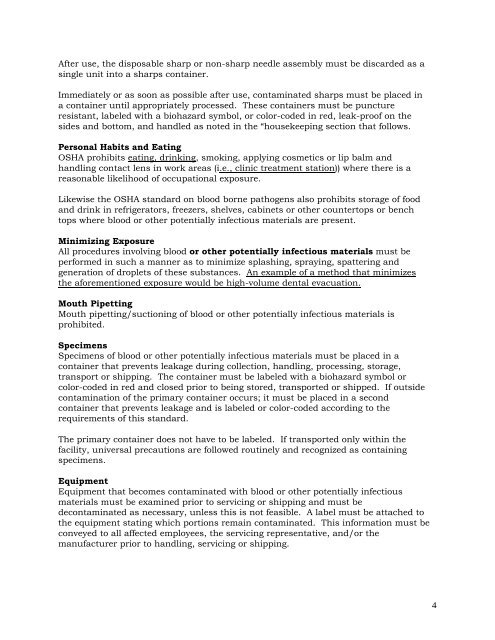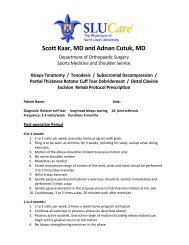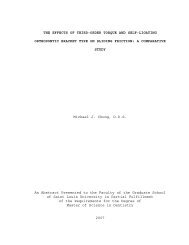Program Manual - Saint Louis University
Program Manual - Saint Louis University
Program Manual - Saint Louis University
You also want an ePaper? Increase the reach of your titles
YUMPU automatically turns print PDFs into web optimized ePapers that Google loves.
After use, the disposable sharp or non-sharp needle assembly must be discarded as a<br />
single unit into a sharps container.<br />
Immediately or as soon as possible after use, contaminated sharps must be placed in<br />
a container until appropriately processed. These containers must be puncture<br />
resistant, labeled with a biohazard symbol, or color-coded in red, leak-proof on the<br />
sides and bottom, and handled as noted in the “housekeeping section that follows.<br />
Personal Habits and Eating<br />
OSHA prohibits eating, drinking, smoking, applying cosmetics or lip balm and<br />
handling contact lens in work areas (i.e., clinic treatment station)) where there is a<br />
reasonable likelihood of occupational exposure.<br />
Likewise the OSHA standard on blood borne pathogens also prohibits storage of food<br />
and drink in refrigerators, freezers, shelves, cabinets or other countertops or bench<br />
tops where blood or other potentially infectious materials are present.<br />
Minimizing Exposure<br />
All procedures involving blood or other potentially infectious materials must be<br />
performed in such a manner as to minimize splashing, spraying, spattering and<br />
generation of droplets of these substances. An example of a method that minimizes<br />
the aforementioned exposure would be high-volume dental evacuation.<br />
Mouth Pipetting<br />
Mouth pipetting/suctioning of blood or other potentially infectious materials is<br />
prohibited.<br />
Specimens<br />
Specimens of blood or other potentially infectious materials must be placed in a<br />
container that prevents leakage during collection, handling, processing, storage,<br />
transport or shipping. The container must be labeled with a biohazard symbol or<br />
color-coded in red and closed prior to being stored, transported or shipped. If outside<br />
contamination of the primary container occurs; it must be placed in a second<br />
container that prevents leakage and is labeled or color-coded according to the<br />
requirements of this standard.<br />
The primary container does not have to be labeled. If transported only within the<br />
facility, universal precautions are followed routinely and recognized as containing<br />
specimens.<br />
Equipment<br />
Equipment that becomes contaminated with blood or other potentially infectious<br />
materials must be examined prior to servicing or shipping and must be<br />
decontaminated as necessary, unless this is not feasible. A label must be attached to<br />
the equipment stating which portions remain contaminated. This information must be<br />
conveyed to all affected employees, the servicing representative, and/or the<br />
manufacturer prior to handling, servicing or shipping.<br />
4

















